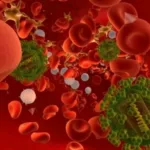I always thought that black is black and there is not much to discuss, but in the world of science numbers count not perception. Quoting Wikipedia “Black is the darkest color, the result of the absence of or complete absorption of light.”, that sounds pretty much like a black hole where light is completely absorbed. Vantablack is a substance made of carbon nanotubes that can absorb up to 99.945% of light, that is maybe as close as you can get to complete absorbtion of light.
When you look at a surface or object coated with Vantablack, because nearly no light is reflected, you can not recognize the shape or any contours; all you see is a flat two dimensional black hole. The picture below shows a piece of Vantablack-coated aluminium foil, as you can see, you can see nothing, the structure seems completely flat although it is wrinkled like the non-coated part.

Vanta comes from Vertically Aligned NanoTube Arrays. The material is like a forest of vertically “grown” carbon nanotubes which trap light, continually deflected it between the tubes before it eventually becomes heat.

The product is already being sold to aerospace agencies, to reduce light reflection in telescopes and consequently reduce the noise on space images. The other big buyer is the military who hopes to build stealther airplanes and camouflage ground vehicles more effectively.








